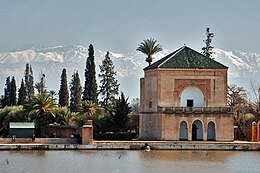|
Marrakesh
|
|
|---|---|

Map of Marrakesh
|
|
| Coordinates: 31°37′48″N 8°0′32″W | |
| Country | |
| Region | Marrakesh-Safi |
| Prefecture | Marrakesh |
| Established | 1070 |
| Founded by | Abu Bakr ibn Umar |
| Government
|
|
| • Mayor | Fatima Ezzahra El Mansouri |
| Elevation
|
466 m (1,529 ft) |
| Population
(2014)[1]
|
|
| • Total | 928,850 |
| • Rank | 4th in Morocco[a] |
| Demonym | Marrakshi |
| Time zone | UTC+1 (CET) |
|
|
| Official name | Medina of Marrakesh |
| Criteria | Cultural: i, ii, iv, v |
| Reference | 331 |
| Inscription | 1985 (9th Session) |
| Area | 1,107 ha |
Marrakesh or Marrakech (/məˈrækɛʃ/ or /ˌmærəˈkɛʃ/;[3] Arabic: مراكش, romanized: murrākuš, pronounced [murraːkuʃ]; Berber languages: ⵎⵕⵕⴰⴽⵛ, romanized: mṛṛakc[4]) is the fourth largest city in Morocco.[2] It is one of the four imperial cities of Morocco and the capital of the Marrakesh–Safi region. It is west of the foothills of the Atlas Mountains.
The region has been inhabited by Berber farmers since Neolithic times. The city was founded in 1070 by Emir Abu Bakr ibn Umar as the imperial capital of the Almoravid Empire. The Almoravids established the first major structures in the city and shaped its layout for centuries to come. The red walls of the city, built by Ali ibn Yusuf in 1122–1123, and various buildings constructed in red sandstone afterwards, have given the city the nickname of the “Red City” (المدينة الحمراء Almadinat alhamra’) or “Ochre City” (ville ocre). Marrakesh grew rapidly and established itself as a cultural, religious, and trading center for the Maghreb.
After a period of decline, the city was surpassed by Fez. Marrakesh gained its preeminence in the early 16th century serving as the capital of the Saadian dynasty, with sultans Abdallah al-Ghalib and Ahmad al-Mansur embellishing the city with sumptuous palaces such as the El Badi Palace (1578) and restoring many ruined monuments. Beginning in the 17th century, the city became popular among Sufi pilgrims for its seven patron saints who are entombed within the city’s quarters. In 1912 the French Protectorate in Morocco was established and T’hami El Glaoui became Pasha of Marrakesh and held this position nearly throughout the protectorate until the role was dissolved upon the independence of Morocco and the reestablishment of the monarchy in 1956.
Marrakesh comprises an old fortified city packed with vendors and their stalls. This medina quarter is a UNESCO World Heritage Site. The city is one of the busiest in Africa, with Jemaa el-Fnaa being the busiest square in the continent, and serves as a major economic center and tourist destination. Real estate and hotel development in Marrakesh have grown dramatically in the 21st century. Marrakesh is particularly popular with the French, and numerous French celebrities own property in the city. Marrakesh has the largest traditional market (souk) in Morocco, with some 18 souks. Crafts employ a significant percentage of the population, who primarily sell their products to tourists.
Marrakesh is served by Ménara International Airport and by Marrakesh railway station, which connects the city to Casablanca and northern Morocco. Marrakesh has several universities and schools, including Cadi Ayyad University. A number of Moroccan football clubs are here, including Najm de Marrakech, KAC Marrakech, Mouloudia de Marrakech and Chez Ali Club de Marrakech. The Marrakesh Street Circuit hosts the World Touring Car Championship, Auto GP and FIA Formula Two Championship races.
Etymology[edit]
The exact meaning of the name is debated.[5] One possible origin of the name Marrakesh is from the Berber (Amazigh) words amur (n) akush (ⴰⵎⵓⵔ ⵏ ⴰⴽⵓⵛ), which means “Land of God”.[4] According to historian Susan Searight, however, the town’s name was first documented in an 11th-century manuscript in the Qarawiyyin library in Fez, where its meaning was given as “country of the sons of Kush”.[6] The word mur [7] is used now in Berber mostly in the feminine form tamurt. The same word “mur” appears in Mauretania, the North African kingdom from antiquity, although the link remains controversial as this name possibly originates from μαύρος mavros, the ancient Greek word for black.[5] The common English spelling is “Marrakesh”,[8][9] although “Marrakech” (the French spelling) is also widely used.[4] The name is spelled Mṛṛakc in the Berber Latin alphabet, Marraquexe in Portuguese, Marrakech in Spanish.[10] A typical pronunciation in Moroccan Arabic is marrākesh with stress on the second syllable, while vowels in the other syllables may be barely pronounced.
From medieval times until around the beginning of the 20th century, the entire country of Morocco was known as the “Kingdom of Marrakesh”, as the kingdom’s historic capital city was often Marrakesh.[11][12] The name for Morocco is still “Marrakesh” (مراكش) to this day in Persian and Urdu as well as many other South Asian languages. Various European names for Morocco (Marruecos, Marrocos, Maroc, Marokko, etc.) are directly derived from the name Murrākush. Conversely, the city itself was in earlier times simply called Marocco City (or similar) by travelers from abroad. The name of the city and the country diverged after the Treaty of Fez divided Morocco into a French protectorate in Morocco and Spanish protectorate in Morocco, and the old interchangeable usage lasted widely until about the interregnum of Mohammed Ben Aarafa (1953–1955).[13] The latter episode set in motion the country’s return to independence, when Morocco officially became المملكة المغربية (al-Mamlaka al-Maġribiyya, “The Maghreb Kingdom”), its name no longer referring to the city of Marrakesh. Marrakesh is known by a variety of nicknames, including the “Red City”, the “Ochre City” and “the Daughter of the Desert”, and has been the focus of poetic analogies such as one comparing the city to “a drum that beats an African identity into the complex soul of Morocco.”[14]







